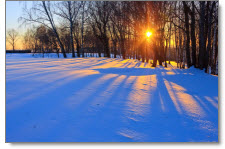 Many of us notice increasing tiredness and difficulty getting out of bed as autumn turns to winter. In fact, for centuries, writers have portrayed the shorter days of the calendar year as a time of sadness, loss and lethargy. But for some people, winter causes a noticeable exacerbation of these symptoms, and their depression and lack of energy can become immobilizing. This condition, known as Seasonal Affective Disorder (SAD), is today recognized by the American Psychiatric Association as a subtype of major depression. It is believed to affect more than 10 million Americans, or roughly 3 percent of the population.
Many of us notice increasing tiredness and difficulty getting out of bed as autumn turns to winter. In fact, for centuries, writers have portrayed the shorter days of the calendar year as a time of sadness, loss and lethargy. But for some people, winter causes a noticeable exacerbation of these symptoms, and their depression and lack of energy can become immobilizing. This condition, known as Seasonal Affective Disorder (SAD), is today recognized by the American Psychiatric Association as a subtype of major depression. It is believed to affect more than 10 million Americans, or roughly 3 percent of the population.
Although SAD isn’t understood completely, it is a bona fide syndrome with potentially severe symptoms. These symptoms include depression, lethargy, an increased need for sleep, cravings for sweets and weight gain. Symptoms usually begin in late fall, peak during winter, and taper off in spring.
SAD appears to be caused by our bodies’ response to seasonal changes. It seems our daily circadian rhythms shift with the seasons, partly in response to changes in patterns of sunlight. When the daylight hours shorten during late fall and winter, some individuals experience a biochemical imbalance in the brain. SAD can also affect individuals who work at night and sleep during the day – some 20 percent of the workforce – and people who live in areas that experience significant cloud cover. Young people and women are at the highest risk for the disorder, but SAD can affect anyone.
From a treatment perspective, light therapy – also known as phototherapy – has proven to be effective in up to 35 percent of diagnosed cases. With light therapy, the patient is exposed to a very bright light – at least 10 times the intensity of ordinary domestic lighting — for up to four hours a day (though one to two hours is the average).
The patient typically sits two to three feet away from a specially designed light box. Reputable light-box manufacturers include Bio-Light, Sun-Box and Northern Light Technologies. This bright light activates the circuits in the brain that cause mood-boosting chemical reactions. While sitting in front of the light box, the patient can engage in normal activities, such as reading and eating. Treatment is usually effective within three or four days, and the benefits continue with daily use.
 Another way of tackling SAD is to get more exposure to outdoor sunlight. According to one study, one hour of walking in winter sunlight is just as effective at combating SAD as two and a half hours under bright artificial light.
Another way of tackling SAD is to get more exposure to outdoor sunlight. According to one study, one hour of walking in winter sunlight is just as effective at combating SAD as two and a half hours under bright artificial light.
Yet another treatment option is taking antidepressants, such as Prozac, Zoloft, Celexa and Lexapro. These medications have been found effective in alleviating the depressive symptoms of SAD, and they combine well with light therapy.
Before embarking on any course of treatment, it is best to have your clients schedule a complete medical evaluation and discuss possible treatment options with their physician or other healthcare professional. Understandably, clients want to send the winter blues packing as quickly as possible. But if an undiagnosed physical illness is causing or contributing to the depression, this should be uncovered first.
————————————————————
Joe Wegmann is a licensed clinical social worker and a clinical pharmacist with over 30 years of experience in counseling and medication treatment of depression and anxiety. Joe’s new book, Psychopharmacology: Straight Talk on Mental Health Medications is available at www.pesi.com. To learn more about Joe’s programs or to contribute a question for Joe to answer in a future article, visit his website at www.thepharmatherapist.com, or e-mail him at joe@thepharmatherapist.com.